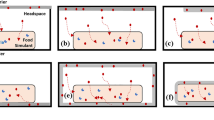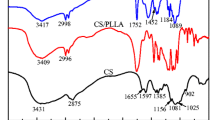Abstract
The need for safe food products has motivated food scientists and industry to find novel technologies for antimicrobial delivery for improving food safety and quality. Controlled release packaging is a novel technology that uses the package to deliver antimicrobials in a controlled manner and sustain antimicrobial stress on the targeted microorganism over the required shelf life. This work studied the effect of controlled release of nisin to inhibit growth of Micrococcus luteus (a model microorganism) using a computerized syringe pump system to mimic the release of nisin from packaging films which was characterized by an initially fast rate and a slower rate as time progressed. The results show that controlled release of nisin was strikingly more effective than instantly added (“formulated”) nisin. While instant addition experiments achieved microbial inhibition only at the beginning, controlled release experiments achieved complete microbial inhibition for a longer time, even when as little as 15% of the amount of nisin was used as compared to instant addition.





Similar content being viewed by others
References
Balasubramanian A, Rosenberg LE, Yam K, Chikindas ML (2009) Antimicrobial packaging: potential vs. reality—a review. J Appl Packag Res 3:193–221
Chi-Zhang Y, Yam KL, Chikindas ML (2004) Effective control of Listeria monocytogenes by combination of nisin formulated and slowly released into a broth system. Int J Food Microbiol 90:15–22
Choi JH, Choi WY, Cha DS, Chinnan MJ, Park HJ, Lee DS, Park JM (2005) Diffusivity of potassium sorbate in [kappa]-carrageenan based antimicrobial film. LWT-Food Sci Technol 38:417–423
Crank J (1975) The mathematics of diffusion. Clarendon Press, Oxford
Grande MJ, Lucas R, Valdivia E, Abriouel H, Maqueda M, Omar NB, Amero MM, Ga′lvezl A (2005) Stability of enterocin AS-48 in fruit and vegetable juices. J Food Prot 68(10):2085–2094
Kim YM, An DS, Park HJ, Park JM, Lee DS (2002) Properties of nisin-incorporated polymer coatings as antimicrobial packaging materials. Packag Technol Sci 15:247–254
LaCoste A, Schaich KM, Zumbrunnen D, Yam KL (2005) Advancing controlled release packaging through smart blending. Packag Technol Sci 18:77–87
Min S, Rumsey TR, Krochta JM (2008) Diffusion of the antimicrobial lysozyme from a whey protein coating on smoked salmon. J Food Eng 84:39–47
Ouattara B, Simard RE, Piette G, Bin A, Holley RA (2000) Diffusion of acetic and propionic acids from chitosan-based antimicrobial packaging films. J Food Sci 65:768–773
Redl A, Gontard N, Guilbert S (1996) Determination of sorbic acid diffusivity in edible wheat gluten and lipid based films. J Food Sci 61:116–120
Swinnen IAM, Bernaerts K, Dens EJJ, Geeraerd AH, Van Impe JF (2004) Predictive modelling of the microbial lag phase: a review. Int J Food Microbiol 94:137–159
Teerakarn A, Hirt DE, Acton JC, Rieck JR, Dawson PL (2002) Nisin diffusion in protein films: effects of film type and temperature. J Food Sci 67:3019–3025
Thomas LV, Delves-Broughton J (2005) Nisin. In: Davidson PM, Sofos JN, Branen AL (eds) Antimicrobials in food, 3rd edn. CRC Press, Boca Raton, pp 237–274
US Food and Drug Administration (1988) Nisin preparation: affirmation of GRAS status as direct human food ingredient. Federal Register 53, April 6
US Food and Drug Administration (2009) Direct food substances affirmed as generally recognized as safe. 21CFR184, Title 21:3, April 6
United States Department of Agriculture (2010) FSIS recalls. [cited 2010 February 19]; Available from: http://www.fsis.usda.gov/recalls/Open_Federal_Cases/index.asp?src_location=Content&src_page=FSISRecalls
Acknowledgments
This work was supported by “National Research Initiative Grant 2006-35503-17568 from the USDA Cooperative State Research, Education, and Extension Service Program on Improving Food Quality and Value.”
Author information
Authors and Affiliations
Corresponding author
Rights and permissions
About this article
Cite this article
Balasubramanian, A., Lee, D.S., Chikindas, M.L. et al. Effect of Nisin’s Controlled Release on Microbial Growth as Modeled for Micrococcus luteus . Probiotics & Antimicro. Prot. 3, 113–118 (2011). https://doi.org/10.1007/s12602-011-9073-8
Published:
Issue Date:
DOI: https://doi.org/10.1007/s12602-011-9073-8




